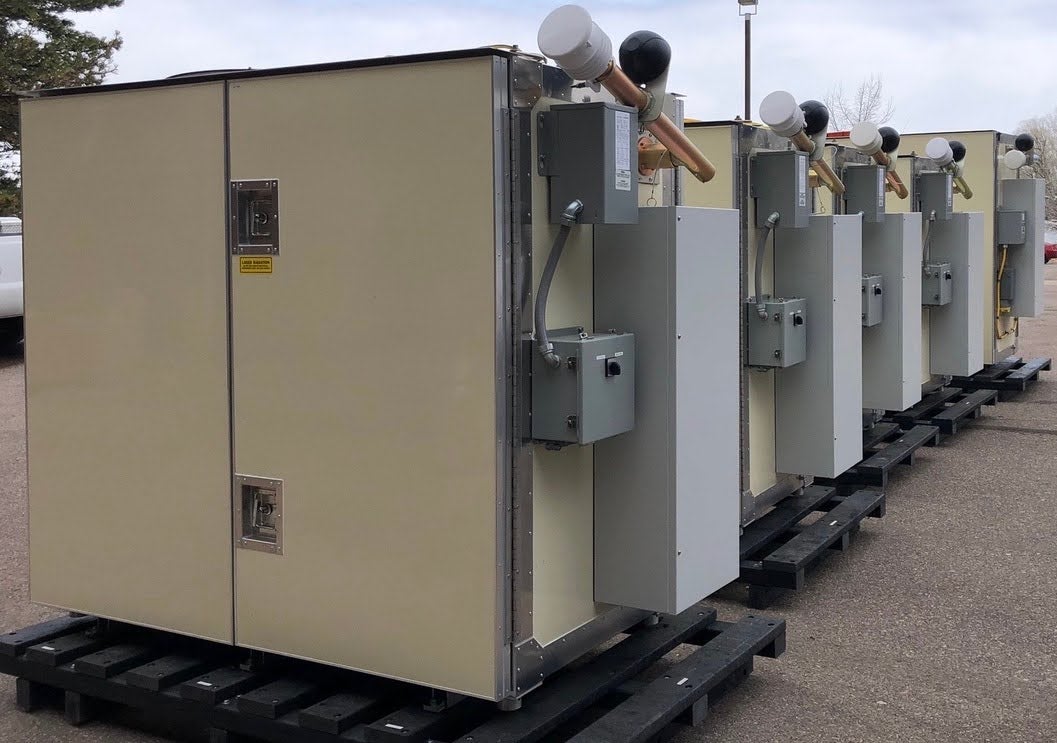Transforming severe weather forecasting
Licensing agreement opens door to widespread use of weather instrument
Feb 7, 2025 - by Audrey Merket
Feb 7, 2025 - by Audrey Merket

Five-unit network of MicroPulse DIALs preparing to be tested in April 2019 in Boulder, CO. (Image: Scott Spuler/NSF NCAR)
| Impact statement: Commercialization of the MicroPulse DIAL instrument offers a low-cost, technical solution for improving severe weather prediction. |
An innovative weather instrument developed at the U.S. National Science Foundation National Center for Atmospheric Research (NSF NCAR) could be a solution for improving severe weather prediction.
Accurate, localized forecasts are needed to improve predictions of severe weather events like hail storms or flooding. While the technology exists to measure the elements necessary for this type of forecasting, the cost of the instruments limits forecasters' ability to acquire data from enough locations and at the frequency required. In response to this problem, researchers at NSF NCAR have developed the MicroPulse Differential Absorption Lidar (MicroPulse DIAL or MPD). The MPD utilizes low-cost lasers to affordably collect high-quality, continuous data about Earth’s lower atmosphere.
To make the leap from prototype to widely used instrument, the MPD development team began seeking partners that can commercially produce the instrument and make the technology more widely available. EKO Instruments Co., Ltd., a company based in Japan, has signed a licensing agreement for the basic patents of the MPD, becoming the first commercial partner for the instrument.
The patents for the MPD are jointly owned by Montana State University, NASA, and the University Corporation for Atmospheric Research (UCAR) – the nonprofit organization that manages NSF NCAR. The development of the MPD has been largely funded by NSF.
“This technology has been in development for a long time and we are proud that the commercial license will enable tax-dollar-funded, research-based technology developments to help improve advanced warnings and public safety,” said Bonnie Meinke, UCAR director of external engagement and business development. “NSF NCAR has a strong history of technology transfer for the advancement of Earth system science, and this license represents a continuation of that legacy.”
Currently, weather forecasts are based in part on information from radiosondes, which are small instrument packages that attach to a weather balloon. Twice daily, the National Weather Service launches radiosondes at 69 locations in the contiguous U.S. to collect data on pressure, temperature, and humidity. The cost and effort required to obtain this data has limited the data collection locations and frequency of collection.
“To have more accurate forecasts in an area the size of the conterminous United States, especially for severe weather events, we really need these observations at least four to eight times a day at 200-300 sites,” said NSF NCAR research engineer Scott Spuler. “Developing a solution to do that has primarily been an economic problem, but it is also a technology problem. The MPD is a sophisticated solution to both problems.”
The MPD offers the capability to take continual measurements at a lower price tag by using semiconductor lasers that have decreased in price and become more widely used in recent years. Refined by NSF NCAR through a decade of research and testing in multiple field campaigns, the MPD is able to make sustained, reliable measurements of water vapor, aerosols, and temperature in the lower atmosphere.
NSF NCAR has developed a small set of the instruments, but not enough to benefit the entire research community. It is expected that through the technology transfer process, not only will the instrument be more widely available, but the reliability and robustness of the MPDs will be improved.
“This is something that the weather research community has wanted for a long time, and I think this is going to be beneficial,” said Spuler. “It’s great to see how this R&D work can become something that significantly impacts society.”